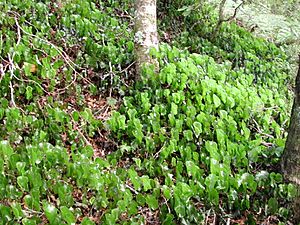Kidney fern facts for kids
Quick facts for kids Kidney fern |
|
|---|---|
 |
|
| Scientific classification | |
| Genus: |
Hymenophyllum
|
| Species: |
nephrophyllum
|
| Synonyms | |
|
|
The kidney fern, scientifically known as Hymenophyllum nephrophyllum, is a special type of fern found only in New Zealand. It often grows on the ground in native forests. Its leaves, called fronds, are shaped like a kidney and can stand about 5–10 cm tall.
When the weather gets hot and dry, these ferns curl up tightly. This helps them save water. But as soon as it rains, they uncurl and become green again! Their fronds are very thin, only about four to six cells thick. In the Māori language, people also call this fern raurenga. You can find H. nephrophyllum in places like Westland, New Zealand, growing alongside other ferns.
Contents
What Does the Kidney Fern Look Like?
The kidney fern, Hymenophyllum nephrophyllum, is easy to spot because of its unique kidney-shaped fronds. These fronds are not divided into smaller parts. They are 3–10 cm long and 4–13 cm wide. They have a shiny, see-through green color.
The fronds are so thin that light can pass through them. When the fern is very young, its fronds are only one cell thick. As it grows, they become 3-4 cells thick. The fronds grow on thin, easily broken stems called stipes, which are 5–25 cm long.
When the fern is fully grown, you can see small brown bumps along the top edge of its fronds. These bumps are called sori. They are groups of tiny cases, called sporangia, that hold the fern's spores.
Like some other filmy ferns, the kidney fern can curl up tightly when it's dry. This helps it stop losing water. This ability gives it another Māori name, kopakopa, which means "to wrap or clasp." After rain, it quickly opens up and recovers.
Naming the Kidney Fern
The kidney fern has had a few scientific names over time. It was once called Trichomanes reniforme and Cardiomanes reniforme. However, scientists have studied its DNA and found that it belongs in the group Hymenophyllum. This is why its current scientific name is Hymenophyllum nephrophyllum.
The name nephrophyllum comes from Greek words. Nephro- means "kidney-shaped," and -phyllus means "leaved." So, the name describes its kidney-shaped fronds. The older names, reniforme and Cardiomanes, also refer to the frond's shape. Reniforme means "kidney-shaped," and Cardiomanes comes from Greek words meaning "heart" and "thin."
Where Does the Kidney Fern Live?
Global Home
The kidney fern, Hymenophyllum nephrophyllum, is endemic to New Zealand. This means it is found naturally only in New Zealand and nowhere else in the world. However, other types of ferns in the Hymenophyllum group can be found in many places around the globe.
New Zealand Locations
You can find the kidney fern all over the North Island of New Zealand. It also grows in the northern, western, and southern parts of the South Island. It is present on Stewart Island and the Chatham Islands too. It is not usually found on the eastern side of the South Island.
Favorite Places to Grow
The kidney fern can live in many different places, from wet forests to areas with lava rock. But it likes moist forests the most, usually up to 780 meters high. This is probably why it's not common on the drier eastern side of the South Island.
Its ability to curl up and save water helps it survive in different habitats. The kidney fern often covers the forest floor like a thick mat. It also grows on banks, rocks, fallen trees, and even as an epiphyte on the lower parts of tree trunks and branches.
Life Cycle and How It Spreads
Like all ferns, the kidney fern, Hymenophyllum nephrophyllum, makes new plants using spores. It has special tube-like structures called indusia that stick out from the edge of its fronds. These indusia protect the developing spores.
Inside the indusia, stalks grow with sporangia (spore cases) on them. When the fern is mature, these sporangia release their tiny spores. The kidney fern also spreads by vegetative reproduction. It sends out long, creeping underground stems called rhizomes. These rhizomes help form the thick mats of fronds you see on the forest floor. Not much else grows in these mats because the rhizomes release a chemical that stops other plant seedlings from growing their roots.
How the Kidney Fern Gets What It Needs
For the fern's life cycle to happen, the soil needs to be damp. Its spores grow best in a moist environment. Since Hymenophyllum nephrophyllum mostly lives in moist forests, it needs fairly damp soil.
However, the kidney fern is also poikilohydric. This means it can adapt to different amounts of water. It can store water during dry times by shriveling up. Then, it expands again when rain returns.
Who Eats the Kidney Fern?
Caterpillars from the moth family Tortricidae are known to eat the kidney fern. These caterpillars are sometimes called "filmy-fern leaf-tyer moths." You might find them in silk tubes attached to the fern's fronds. They might even weave the fronds together or bend them inwards to hide from predators.
The biggest threats to ferns like the kidney fern are human activities. These include clearing forests, which destroys their homes, and invasive plants that are brought in and take over their space.
Other Interesting Facts
The Māori have traditionally used Hymenophyllum nephrophyllum in several ways. Some believed it could help with bowel problems, though this is debated. It was also used as a perfume plant and sometimes worn during times of mourning. Other Māori names for the kidney fern include konehu and raurenga.

